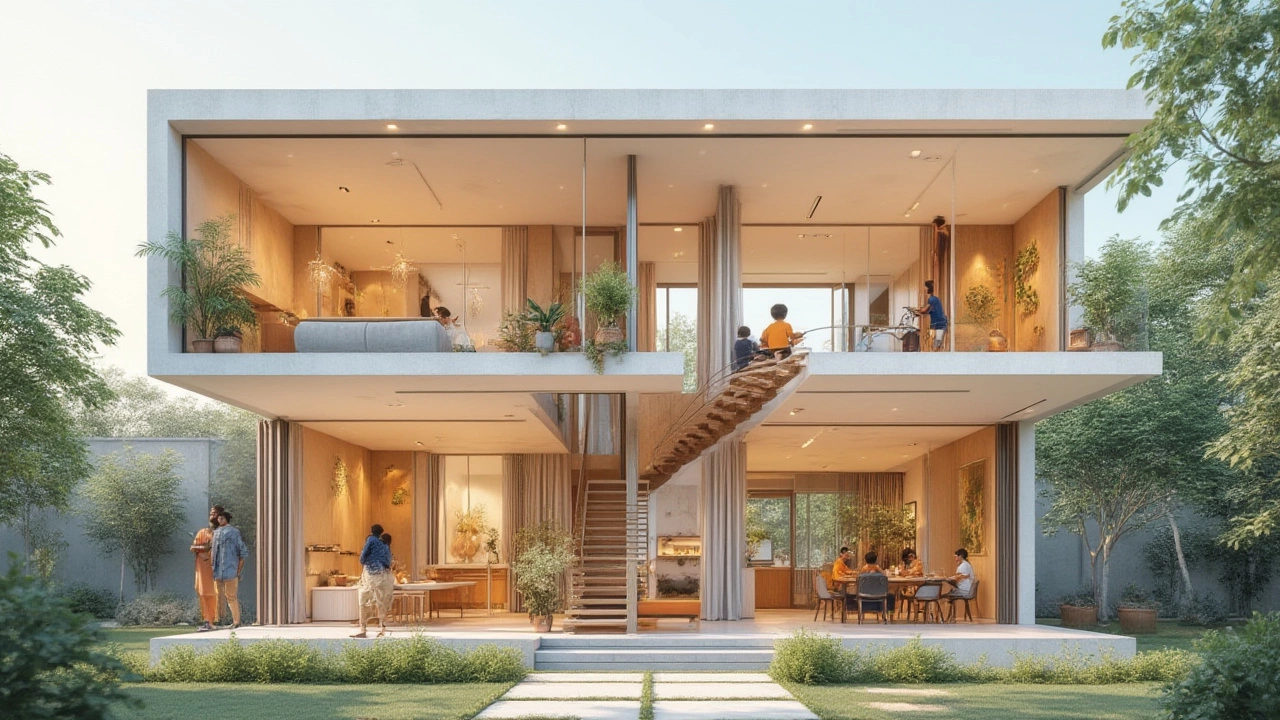Backsplit Houses Explained: Unique Real Estate Design & Why People Love Them

Picture this: you step into a home, and you’re immediately thrown off—in the best way. The layout doesn’t march you room-by-square room along a hallway stretching into the unknown. Instead, stairs split off in different directions, rooms sit at half-levels, and the house itself seems to play a game with gravity. For a moment, you wonder if you’ve stumbled into an architectural experiment. Welcome to the world of the backsplit.
What Makes a Backsplit? Origins, Features, and Varieties
A backsplit is a special kind of split-level house, but it’s not just about throwing a staircase somewhere random. The key is how the house steps up—quite literally. In a classic backsplit, the front of the house appears to be a single story, sometimes even with a bungalow-like facade. But sneak around to the side or back, and you’ll see the structure rising in staggered levels, each split running parallel to the front. Most commonly, you’ll find two-level (split into main and basement) or three-level backsplits, while four-level versions—popular in parts of North America from the 1960s onwards—are the showstoppers.
This design isn't exactly new. The backsplit style exploded in popularity after World War II, especially between the 1950s and 1970s. Family sizes were booming, city footprints were growing, and buyers wanted more room than the standard single-level home. Instead of going wide—and needing a massive section—builders went up and back, stacking living spaces in clever half-levels that let you fit more square footage on a compact lot.
Architecturally, backsplits break from the boxy traditions of the past. Bedrooms typically perch a half-flight up from the living area, while basements or recreation rooms sit a half-flight down. The effect is a house that never feels flat or monotonous. Natural light finds its way into more corners, thanks to clever window placements. The separation of levels means more privacy; teens or parents can enjoy some peace while others cook or watch telly. Some backsplits even have walkouts from the lower level into the backyard, which is a rare treat in split-level driving neighbourhoods.
The design has its quirks, too. Floor plans can feel like a maze until you’re used to the split layout. You may wander from a kitchen to a living room on a completely different level, which isn't everyone’s cup of tea. But for many, this multi-level approach actually makes a big home feel even bigger, and that’s why it’s stuck around through generations.
The Day-to-Day Experience: What’s It Like Living in a Backsplit?
It’s the everyday stuff that gets interesting in a backsplit. Walk in the front door, and you usually find yourself in the main living area—sometimes a light-soaked living room, sometimes right in the hustle of the kitchen. A short staircase up leads to bedrooms and sometimes a bathroom or two. Head a half-flight down instead, and you get a basement or “rec room,” perfect for movie nights, a noisy hobby, or even extra bedrooms in those sprawling four-level versions.
One of the most appreciated points? Privacy. Parents can retreat upstairs, kids crash out downstairs, and there’s rarely a straight line of sight or sound between them. No more tiptoeing past bedrooms just to get to the bathroom in the middle of the night. Entertaining is easier, too—you can keep noisy guests on one level without turning the whole house into a party zone.
Those steps do add up. You’re constantly heading up or down a short staircase when moving between zones. If mobility’s an issue, a backsplit can be a tough sell—steps are everywhere, even if they’re just a few at a time. But for most families, the staircase rhythm quickly becomes second nature, and the split design grows on you.
Another benefit: extra storage. The way backsplits are built often means deep closets, utility rooms tucked under stairs, and creative use of every square metre. Some homeowners even add hidden nooks or convert basements into home offices or gyms, especially since remote work spiked after 2020. Look in online forums and you’ll find dozens of hacks for maximising space—things like under-stairs pantries and “bonus” rooms that weren’t even on the original plans.
Light and air flow surprise some people. Because backsplits bounce levels upward as you go back, it’s easier to get windows on all sides, so lower levels don’t feel like a conventional basement dungeon. Chimneys, heat registers, and ductwork—often more visible in older backsplits—do a lot of heavy lifting to keep temperatures balanced in a house where warm air wants to rise. Owners update these systems over time, helping the design keep up with modern comfort standards.

Why Backsplit Homes Appeal to Buyers—and What to Watch Out For
A backsplit’s appeal boils down to a few clear points: more space on a smaller lot, extra privacy between living and sleeping zones, and a funky, retro layout that dodges cookie-cutter vibes. Price-wise, they’re sometimes more affordable per square metre than big two-storey homes or new builds, especially in older neighbourhoods where the infrastructure is already locked in.
If you want numbers, a 2023 real estate survey in Ontario, Canada—where backsplits are everywhere—found they sold, on average, for 10-18% less than comparable detached two-storey homes, mainly because some buyers prefer open-concept modern spaces. But for buyers who don’t mind a little nostalgia, or who want to avoid stairs running up three straight stories, backsplits make a lot of sense.
There’s another angle: renovation potential. The way backsplits separate living zones means you can redo part of the house without disturbing everything else. Many owners remove a few non-load-bearing walls or open up kitchens to the living room for that coveted “modern flow” while keeping the benefits of separated levels.
On the flip side, resale can require patience. Because their unique design doesn’t appeal to everyone—especially young buyers used to huge open-plan layouts—they can spend a bit longer on the market. Maintenance is another point to flag. Older backsplits, especially those from the 1970s, sometimes have quirks with plumbing or wiring because of how services had to zigzag through half-levels. If you’re house-hunting, a good building inspection is a must. Watch for signs of water ingress, especially in lower-level walkouts where drainage wasn’t always up to modern codes.
Here’s a tip: use a reputable agent who knows the local history of backsplits. They’ll spot the differences between a well-maintained gem and a renovation headache. Don’t forget to check council records for permits on past renovations—some “fixes” can hide bigger problems if not done by professionals.
Tips for Buying, Selling, or Renovating a Backsplit
If you’re thinking about owning a backsplit—whether you’re upsizing for a growing family or hunting for investment potential—there are a few street-smart moves that make the difference.
- Study the layout. Every backsplit is a little different. Walk through at different times of day, and pay attention to how light and sound travel.
- Ask about updates. Has the wiring, plumbing, or insulation been brought up to scratch? Older builds can hide surprises, especially if they haven’t had a reno in a decade or two.
- Think about stair safety. If you’ve got little kids or older adults living with you, see if stair gates or handrails are easily installed.
- Look at backyard access. Some backsplits have fantastic flow between the lower level and the garden, making summer living a breeze. Others tuck you away in the backyard with little outdoor access—check that it matches your lifestyle.
- When selling, stage it right. Use mirrors and light colours to make the most of natural light, and open up doors or partitions where possible. Modern buyers appreciate an airy feel, even in a retro-built home.
Renovating? Focus on the entryway. First impressions mean everything, especially in a home where you're immediately greeted by stairs. Open up sightlines if you can, and consider reconnecting rooms (like kitchen-to-living room pass-throughs) for a more inviting vibe.
If you’re shopping for a backsplit as an investment, check out comparable rent rates. In many New Zealand and Canadian cities, backsplits fetch solid rents because of their adaptability and attractiveness to families or roommates who want shared space but also private retreats.
And if you’re curious about how backsplits compare to other home designs, here’s a quick breakdown:
| Home Style | Lot Size | Number of Levels | Estimated Avg. Price (Auckland, 2024) | Key Feature |
|---|---|---|---|---|
| Backsplit | Small–medium | 2–4 (split) | $1,115,000 | Staggered half-levels, more privacy |
| Bungalow | Medium | 1 | $1,180,000 | Single floor living |
| Two-storey | Medium–large | 2 | $1,255,000 | Traditional separation of living/sleeping |
| Townhouse | Small | 2–3 | $970,000 | Attached on one or both sides |
So, if you’re craving a home with character, stacked spaces, and plenty of chances to make it your own, don’t skip the humble backsplit. A bit quirky, a bit retro, but it’s a style that keeps finding new fans and new lives as families and tastes change. For some, that makes all the difference.
